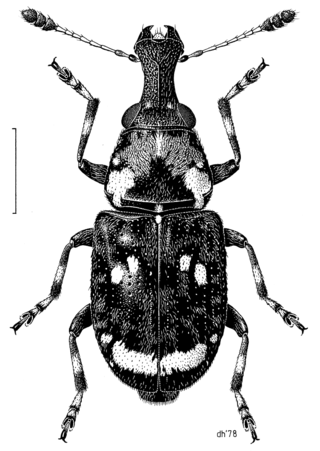
Weevils are beetles belonging to the superfamily Curculionoidea, known for their elongated snouts. They are usually small – less than 6 mm in length – and herbivorous. Approximately 97,000 species of weevils are known. They belong to several families, with most of them in the family Curculionidae. It also includes bark beetles, which while morphologically dissimilar to other weevils in lacking the distinctive snout, is a subfamily of Curculionidae. Some other beetles, although not closely related, bear the name "weevil", such as the biscuit weevil, which belongs to the family Ptinidae.
Caridae is a small Gondwanan family of weevils. They are considered part of the primitive weevil group, because they have straight rather than geniculate (elbowed) antennae. The insertion of the antennae on the rostrum cannot be seen from above. Caridae also lack spiracles on abdominal tergites 6 and 7. The prothorax lacks lateral carinae. It has been suggested that the fossil weevil Eccoptarthrus belongs in this family, which would result in a change in the family name ; this proposal has been rejected by most coleopterists (e.g.)

Anthribidae is a family of beetles also known as fungus weevils. The antennae are not elbowed, may occasionally be longer than the body and thread-like, and can be the longest of any members of Curculionoidea. As in the Nemonychidae, the labrum appears as a separate segment to the clypeus, and the maxillary palps are long and projecting.

Nemonychidae is a small family of weevils, placed within the primitive weevil group because they have straight rather than geniculate (elbowed) antennae. They are often called pine flower weevils. As in the Anthribidae, the labrum appears as a separate segment to the clypeus, and the maxillary palps are long and projecting. Nemonychidae have all ventrites free, while Anthribidae have ventrites 1-4 connate or partially fused. Nemonychidae lack lateral carinae on the pronotum, while these are usually present, though may be short, in Anthribidae.
Eonecrophorus tenuicornis is a species of carrion beetle found in eastern Nepal. First described scientifically by Yoshihiko Kurosawa in 1985, E. tenuicornis is the only species in the genus Eonecrophorus.
Conotrachelus elegans, the pecan gall curculio, is a true weevil species in the genus Conotrachelus. It is found in North America where it feeds on galls of the hickory leaf stem gall phylloxera, found also on pecan.
Mordellistena tenuicornis is a species of beetle in the genus Mordellistena of the family Mordellidae. It was described by Schilsky in 1899.
Cimberis compta is a species of pine flower snout beetle in the family Nemonychidae. It is found in North America.

Cimberis is a genus of pine flower snout beetles in the family Nemonychidae. There are about 10 described species in Cimberis.
Cimberis turbans is a species of pine flower snout beetle in the family Nemonychidae. It is found in North America.
Cimberis elongata is a species of pine flower snout beetle in the family Nemonychidae. It is found in North America.
Hemiphrynus is a genus of flea beetles in the family Chrysomelidae. There are 8 described species from the Nearctic and Neotropics.
Cimberis bihirsuta is a species of pine flower snout beetle in the family Nemonychidae.
Cimberis decipiens is a species of pine flower snout beetle in the family Nemonychidae. It is found in North America.
Acromacer is a genus of pine flower snout beetles in the family Nemonychidae. There is one described species in Acromacer, A. bombifrons.
Cimberis pilosa is a species of pine flower snout beetle in the family Nemonychidae. It is found in North America.
Lecontellus byturoides is a species of pine flower snout beetle in the family Nemonychidae. It is found in North America.
Megataphrus tenuicornis is a species of cylindrical bark beetle in the family Zopheridae. It is found in North America.
Disonycha tenuicornis is a species of flea beetle in the family Chrysomelidae. It is found in Central America and North America.
Hans Silfverberg is a Finnish entomologist. The beetle species Apion silfverbergi, Hyperaspis silfverbergi, and Sasajiscymnus silfverbergi are named in his honour.



